
National People's Army
Encyclopedia
.svg.png)
.svg.png)
German language
German is a West Germanic language, related to and classified alongside English and Dutch. With an estimated 90 – 98 million native speakers, German is one of the world's major languages and is the most widely-spoken first language in the European Union....
Nationale Volksarmee - NVA) were the armed forces of the German Democratic Republic (GDR)
German Democratic Republic
The German Democratic Republic , informally called East Germany by West Germany and other countries, was a socialist state established in 1949 in the Soviet zone of occupied Germany, including East Berlin of the Allied-occupied capital city...
.
The NVA was established in 1956 and disestablished in 1990. There were frequent reports of East German advisors with Communist African countries during the Cold War. It did not see any significant combat, though its participation with the Soviet Armed Forces
Soviet Armed Forces
The Soviet Armed Forces, also called the Armed Forces of the Union of Soviet Socialist Republics and Armed Forces of the Soviet Union refers to the armed forces of the Russian SFSR , and Soviet Union from their beginnings in the...
against the Czech interim government during the Prague Spring
Prague Spring
The Prague Spring was a period of political liberalization in Czechoslovakia during the era of its domination by the Soviet Union after World War II...
of 1968 was cancelled at the last minute.
History
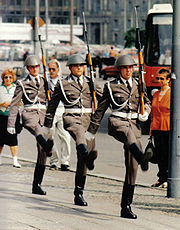
Bundeswehr
The Bundeswehr consists of the unified armed forces of Germany and their civil administration and procurement authorities...
, from the Kasernierte Volkspolizei
Kasernierte Volkspolizei
Kasernierte Volkspolizei were the military units of the Volkspolizei in the German Democratic Republic...
(Barracked People's Police). It was preceded by years of preparation during which former Wehrmacht
Wehrmacht
The Wehrmacht – from , to defend and , the might/power) were the unified armed forces of Nazi Germany from 1935 to 1945. It consisted of the Heer , the Kriegsmarine and the Luftwaffe .-Origin and use of the term:...
officers and Communist veterans of the Spanish Civil War
Spanish Civil War
The Spanish Civil WarAlso known as The Crusade among Nationalists, the Fourth Carlist War among Carlists, and The Rebellion or Uprising among Republicans. was a major conflict fought in Spain from 17 July 1936 to 1 April 1939...
helped organize and train paramilitary units
Kasernierte Volkspolizei
Kasernierte Volkspolizei were the military units of the Volkspolizei in the German Democratic Republic...
of the People's Police
Volkspolizei
The Volkspolizei , or VP, were the national police of the German Democratic Republic . The Volkspolizei were responsible for most law enforcement in East Germany, but its organisation and structure were such that it could be considered a paramilitary force as well...
. With its German appearance—including uniforms and ceremonies patterned after older German military traditions—the doctrine and structure of the NVA were strongly influenced by the Soviet Armed Forces
Soviet Armed Forces
The Soviet Armed Forces, also called the Armed Forces of the Union of Soviet Socialist Republics and Armed Forces of the Soviet Union refers to the armed forces of the Russian SFSR , and Soviet Union from their beginnings in the...
, thus mixing elements of the 20th century's most innovative and successful schools of military in a force which, for its size, was considered one of the most professional and prepared of the world.
Former GDR Interior Minister Willi Stoph served as the first Minister of National Defense between 1956 and 1960. He was followed by Heinz Hoffmann, who was to serve in this capacity until his death in 1985. From its inception, the NVA became an army where professional officers were also expected to be SED cadres. Political officers charged with instruction of the troops on ideological, military, and global affairs formed an essential part of NVA daily routine (Politische Hauptverwaltung/Political Main Administration). By definition, the East German army served “the Party and the people” (“Parteiarmee”), and almost every active officer was a member of the SED.[17] NVA structures took on a repressive and vindictive character against those in uniform who dared to dissent on matters deemed “political”.
During its first year, about 27 percent of the NVA's officer corps had formerly served in the Wehrmacht. Of the 82 highest command positions, 61 were held by ex-Wehrmacht officers. The military knowledge and combat experience of these veterans were indispensable in the NVA's early years, although by the 1960s most of these World War II veterans had been retired. The West German Bundeswehr
Bundeswehr
The Bundeswehr consists of the unified armed forces of Germany and their civil administration and procurement authorities...
similarly relied on Wehrmacht veterans who initially comprised the majority of its commissioned ranks.
In its first six years, the NVA was an all-volunteer force. West Germany
West Germany
West Germany is the common English, but not official, name for the Federal Republic of Germany or FRG in the period between its creation in May 1949 to German reunification on 3 October 1990....
, in contrast, re-introduced universal military service in 1956. Conscription was finally introduced in 1962, and the NVA's strength was increased to approximately 170,000 troops.
Like the Communist parties of other socialist states, the Socialist Unity Party of Germany
Socialist Unity Party of Germany
The Socialist Unity Party of Germany was the governing party of the German Democratic Republic from its formation on 7 October 1949 until the elections of March 1990. The SED was a communist political party with a Marxist-Leninist ideology...
, or SED, assured control by appointing loyal party members to top positions and organizing intensive political education for all ranks. The proportion of SED members in the officer corps rose steadily after the early 1960s, eventually reaching almost 95 percent of the officer corps.
The NVA described itself as the instrument of power of the working class. According to its doctrine, the NVA protected peace and secured the achievements of socialism by maintaining a convincing deterrent to imperalist aggression. The NVA's motto, inscribed on its flag, was "For the Protection of the Workers' and Farmers' Power."
The NVA never took part in full-scale combat, although it participated in a support role in the suppression of the Prague Spring
Prague Spring
The Prague Spring was a period of political liberalization in Czechoslovakia during the era of its domination by the Soviet Union after World War II...
of 1968 and NVA officers often served as combat advisers in Africa. When the Soviet Union prepared to occupy Czechoslovakia, the GDR government originally planned to use the 7th Panzer Division and the 11th Motorized Infantry Division to support the intervention, but fear of international reaction to the deployment of German troops outside Germany for the first time since the Second World War
World War II
World War II, or the Second World War , was a global conflict lasting from 1939 to 1945, involving most of the world's nations—including all of the great powers—eventually forming two opposing military alliances: the Allies and the Axis...
caused second thoughts. Instead, the NVA provided logistical help when Soviet troops advanced into Czechoslovakia and stood at the border ready to intervene in the event that the Soviet Army
Soviet Army
The Soviet Army is the name given to the main part of the Armed Forces of the Soviet Union between 1946 and 1992. Previously, it had been known as the Red Army. Informally, Армия referred to all the MOD armed forces, except, in some cases, the Soviet Navy.This article covers the Soviet Ground...
could not quell the uprising.
During the 1970s, and increasingly in the 1980s, the NVA achieved new standards of mobilization times and combat readiness (Gefechtsbereitschaft). NATO’s submarine-based missiles were seen as its most potent weapon and the hardest to defend against. Ultimately, 85 per cent of all NVA units were on constant alert and trained to depart within 25 to 30 minutes from their bases to designated areas about five to seven kilometers apart. Mobilization of reserves would have been completed within two days. These unprecedented levels of combat readiness were considered the major asset of GDR military deterrence. Needless to say, such preparedness levels placed a huge strain on military professionals and conscripts alike.
In the early 1970s the NVA was assigned the wartime mission of capturing Berlin by the Group of Soviet Forces in Germany
Group of Soviet Forces in Germany
The Group of Soviet Forces in Germany , also known as the Group of Soviet Occupation Forces in Germany and the Western Group of Forces were the troops of the Soviet Army in East Germany....
high command. The NVA plan for the operation was designated 'Operation Centre' and called for some 32,000 troops in two divisions, accompanied by the GSFG's 6th Guards Separate Motor Rifle Brigade. The plan was regularly updated until 1988, when a less ambitious plan that simply aimed at containing Berlin was substituted.
In the autumn of 1981, the NVA stood ready to intervene in Poland
Poland
Poland , officially the Republic of Poland , is a country in Central Europe bordered by Germany to the west; the Czech Republic and Slovakia to the south; Ukraine, Belarus and Lithuania to the east; and the Baltic Sea and Kaliningrad Oblast, a Russian exclave, to the north...
in support of a possible Soviet invasion, but the declaration of martial law in Poland averted the crisis.
The NVA was in a state of heightened combat readiness on several occasions, including the construction of the Berlin Wall
Berlin Wall
The Berlin Wall was a barrier constructed by the German Democratic Republic starting on 13 August 1961, that completely cut off West Berlin from surrounding East Germany and from East Berlin...
in 1961, the Cuban Missile Crisis
Cuban Missile Crisis
The Cuban Missile Crisis was a confrontation among the Soviet Union, Cuba and the United States in October 1962, during the Cold War...
in 1962, the 1968 Warsaw Pact intervention in Czechoslovakia, and, for the last time, in the autumn of 1989 as protests swept through the country.
Ideology
The NVA was a professional volunteer army until 1962, when conscription was introduced. In 1987, at the peak of its power, the NVA numbered 175,300 troops. Approximately 50% of this number were career soldiers, while the others were short-term conscripts. The armed forces were controlled by the National Defense CouncilNational Defense Council of East Germany
The National Defense Council of the German Democratic Republic was created in 1960 as the supreme state body of the GDR in charge of national defense matters, including mobilization planning...
, but the mobile forces were under the Warsaw Pact Unified Command. Political control of the armed forces was through close integration with the Socialist Unity Party of Germany (SED), which vetted all the officers. Popular support for the military establishment was bolstered by military training provided by the school system and through the growing militarization of society. From a Leninist
Leninism
In Marxist philosophy, Leninism is the body of political theory for the democratic organisation of a revolutionary vanguard party, and the achievement of a direct-democracy dictatorship of the proletariat, as political prelude to the establishment of socialism...
perspective, the NVA stood as a symbol of Soviet-East German solidarity and became the model Communist institution—ideological, hierarchical, and disciplined. The NVA synthesized Communist and Germanic symbolism, naming its officers' academy after Karl Marx
Karl Marx
Karl Heinrich Marx was a German philosopher, economist, sociologist, historian, journalist, and revolutionary socialist. His ideas played a significant role in the development of social science and the socialist political movement...
's coauthor Friedrich Engels
Friedrich Engels
Friedrich Engels was a German industrialist, social scientist, author, political theorist, philosopher, and father of Marxist theory, alongside Karl Marx. In 1845 he published The Condition of the Working Class in England, based on personal observations and research...
, and its highest medal after Prussian General Gerhard von Scharnhorst
Gerhard von Scharnhorst
Gerhard Johann David Waitz von Scharnhorst was a general in Prussian service, Chief of the Prussian General Staff, noted for both his writings, his reforms of the Prussian army, and his leadership during the Napoleonic Wars....
.
At the critical moment in its history in November 1989, the NVA rallied to its Germanic heritage and rejected the SED, refusing to battle the demonstrators protesting the regime. Mikhail Gorbachev
Mikhail Gorbachev
Mikhail Sergeyevich Gorbachev is a former Soviet statesman, having served as General Secretary of the Communist Party of the Soviet Union from 1985 until 1991, and as the last head of state of the USSR, having served from 1988 until its dissolution in 1991...
refused to let Soviet troops become engaged, and so, not just the leadership but the entire single party system in East Germany collapsed, and the country was soon absorbed into West Germany.
Post-Unification
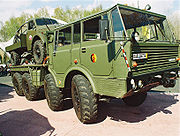
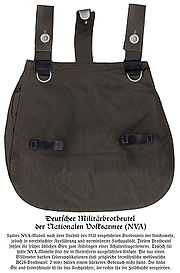
Bundeswehr
The Bundeswehr consists of the unified armed forces of Germany and their civil administration and procurement authorities...
. Most facilities were closed, and equipment was either sold or given to other countries. Most of the NVA's 36,000 officers and NCOs were let go, including all officers above the rank of lieutenant colonel. Only 3,200 were retained by the Bundeswehr after a demotion of one rank. In addition, all female soldiers and all soldiers over the age of 55 were also discharged.
Until March 1, 2005, time served in the NVA was listed as time “served in a foreign military”. Service in the NVA did not count for points towards federal pensions in the unified Germany
Germany
Germany , officially the Federal Republic of Germany , is a federal parliamentary republic in Europe. The country consists of 16 states while the capital and largest city is Berlin. Germany covers an area of 357,021 km2 and has a largely temperate seasonal climate...
. Retired NVA soldiers and officers received only minimal pensions after unification: a thirty-year veteran would receive a pension smaller than a graduate student stipend. After the reform, service in the NVA is known as “served outside of the Bundeswehr”.
Many former NVA officers feel bitter about their treatment after unification. While receiving only minimal pensions, few have been able to find jobs except as laborers or security guards. Former NVA officers are not permitted to append their NVA rank to their name as a professional title; no such prohibition applies to rank attained in the Wehrmacht or Waffen-SS during the Nazi era.
Former Wehrmacht soldiers in the NVA
The following list includes the NVA generals and admirals who were awarded the German CrossGerman Cross
The German Cross was instituted by Adolf Hitler on 17 November 1941 as an award ranking higher than the Iron Cross First Class but below the Knight's Cross of the Iron Cross respectively ranking higher than the War Merit Cross First Class with Swords but below the Knight's Cross of the War Merit...
in the Wehrmacht
Wehrmacht
The Wehrmacht – from , to defend and , the might/power) were the unified armed forces of Nazi Germany from 1935 to 1945. It consisted of the Heer , the Kriegsmarine and the Luftwaffe .-Origin and use of the term:...
during the Second World War with the date of the awards as well as the rank held at the time listed after the name.
- Generalmajor Rudolf BamlerRudolf BamlerRudolf Bamler was a German Wehrmacht leader before and during the Second World War...
(12 Mar 1942 as Oberst) - Generalmajor Bernhard Bechler (28 Jan 1943 as Major)
- Generalmajor Dr. rer. pol. Otto Korfes (11 Jan 1942 as Oberst)
- Generalmajor Arno von LenskiArno von LenskiArno Ernst Max von Lenski was a German military officer and general who served in the Imperial German army, the Wehrmacht, and after the war in the National People's Army of the German Democratic Republic, where he was also a politician.-Early career:Lenski was born in the East Prussian village of...
(21 Jan 1943 as Generalmajor) - Generalleutnant Vincenz MüllerVincenz MüllerVincenz Müller was a German military officer and general who served in the Imperial German army, the Wehrmacht Heer, and after the war in the National People's Army of the German Democratic Republic, where he was also a politician.-Early career:Müller was born in the Kingdom of Bavaria into a...
(26 Jan 1942 as Oberst i.G.) - Generalmajor Hans Wulz (25 Jan 1943 as Generalmajor)
The following list includes the NVA generals and admirals who were awarded the Knight's Cross of the Iron Cross
Knight's Cross of the Iron Cross
The Knight's Cross of the Iron Cross was a grade of the 1939 version of the 1813 created Iron Cross . The Knight's Cross of the Iron Cross was the highest award of Germany to recognize extreme battlefield bravery or successful military leadership during World War II...
in the Wehrmacht
Wehrmacht
The Wehrmacht – from , to defend and , the might/power) were the unified armed forces of Nazi Germany from 1935 to 1945. It consisted of the Heer , the Kriegsmarine and the Luftwaffe .-Origin and use of the term:...
during the Second World War with the date of the awards as well as the rank held at the time listed after the name.
- Generalmajor Wilhelm AdamWilhelm Adam (Politician)Wilhelm Adam was a career military officer who served in three German Armies and later became an East German politician .-Life:Adam's father was a farmer...
(17 Dec 1942 as Oberst) - Generalmajor Dr. rer. pol. Otto Korfes (22 Jan 1943 as Generalmajor)
- Generalleutnant Vincenz MüllerVincenz MüllerVincenz Müller was a German military officer and general who served in the Imperial German army, the Wehrmacht Heer, and after the war in the National People's Army of the German Democratic Republic, where he was also a politician.-Early career:Müller was born in the Kingdom of Bavaria into a...
(7 Apr 1944 as Generalleutnant)
Utilization of former NVA materiel after 1991
.svg.png)
The remaining equipment and materials was very substantial. Large quantites of replacement parts, medical supplies, atomic, biological and chemical warfare
Weapons of mass destruction
A weapon of mass destruction is a weapon that can kill and bring significant harm to a large number of humans and/or cause great damage to man-made structures , natural structures , or the biosphere in general...
equipment, training devices and simulators, etc. had to be disposed of.
One of the first measures taken after reunification
German reunification
German reunification was the process in 1990 in which the German Democratic Republic joined the Federal Republic of Germany , and when Berlin reunited into a single city, as provided by its then Grundgesetz constitution Article 23. The start of this process is commonly referred by Germans as die...
was a survey and securing of weapons and devices by former members of the NVA. The federally operated Material Depot Service Gesellschaft (MDSG) was charged with taking custody of and warehousing this equipment. The MDSG employed 1,820 people who were primarily taken from the Bundeswehr. The MDSG was privatised in 1994. Unless the defense material was given free of charge to beneficiaries in the new federal states or other departments, to museums, or to friendly nations in the context of aid supplies in third world nations, it was destroyed.
Left behind were:
- 767 aircraft (helicopters, fixed wing aircraft), 24 of which were MiG-29s
- 208 ships
- 2,761 tanks
- 133,900 wheeled vehicles
- 2,199 artillery pieces
- 1,376,650 firearms
- 303,690 tons of ammunition
- 14,335 tons of fuel and cleaning materials
Recruitment and conscientious objection
Before the construction of the Berlin Wall in 1961, military service in the GDR was voluntary, though the Free German YouthFree German Youth
The Free German Youth, also known as the FDJ , was the official socialist youth movement of the German Democratic Republic and the Socialist Unity Party of Germany....
and public schools mounted intensive recruitment drives and service in the NVA was often a prerequisite for career advancement. Compulsory service had been introduced earlier in West Germany
West Germany
West Germany is the common English, but not official, name for the Federal Republic of Germany or FRG in the period between its creation in May 1949 to German reunification on 3 October 1990....
(1956)—one year after the Federal Armed Forces were established—but the GDR held back from this step until 1962. The reason was partly that the authorities feared that conscription would swell the ranks of GDR citizens fleeing to the West. The situation changed when the border was sealed in August 1961, and five months later the government announced a mandatory service term of 18 months for men.
There was, at first, no alternative service for conscientious objectors
Conscientious objection in East Germany
-Introduction of conscription:In April 1962 the GDR government introduced military conscription. The period of compulsory service was at least 18 months, and adult males between 18 and 26 were eligible...
. This changed in 1964 when, under pressure from the national Protestant church, the GDR's National Defense Council authorized the formation of Baueinheiten (construction units) for men of draft age who "refuse military service with weapons on the grounds of religious viewpoints or for similar reasons".
The construction soldiers wore uniforms and lived in barracks under military discipline, but were not required to bear arms and received no combat training. In theory, they were to be used only for civilian construction projects. The GDR therefore became the only Warsaw Pact country to provide a non-combat alternative for conscientious objectors. However, fearing that other soldiers would be contaminated by pacifist ideas, the government took care to segregate the construction units from regular conscripts. Moreover, conscripts who chose the alternative service option often faced discrimination later in life, including denial of opportunities for higher education.
Organization
The NVA had four main branches:- The LandstreitkräfteLandstreitkräfteThe Landstreitkräfte , also Army or Heer, was the ground based military branch of the East German National People's Army. The Land Forces Command, located at Geltow was established on 1 December 1972 as a management body created for the land forces...
(Ground Forces) with a strength of 180,000. - The VolksmarineVolksmarineVolksmarine was the official designation of the maritime forces of the German Democratic Republic . It was part of the National People's Army, established in 1956.-History:...
(People's Navy) with a strength of 18,300. - The LuftstreitkräfteLuftstreitkräfte der NVAThe Luftstreitkraefte / Luftverteidigung was the Air Force of East Germany . As with the Landstreitkräfte, the Volksmarine, and the Border troops, it was a military branch of the National People's Army ....
/Luftverteidigung (Air Forces/Air Defence) with a strength of 58,000. - The Grenztruppen der DDR (Border troops of the GDR), consisting of 50,000 border guardBorder guardThe border guard, frontier guard, border patrol, border police, or frontier police of a country is a national security agency that performs border control, i.e., enforces the security of the country's national borders....
s.
In wartime, mobilization of the NVA's reserves would have nearly doubled its strength. GDR authorities also had at their disposal the internal security troops of the Ministry of the Interior (the Kasernierte Volkspolizei
Kasernierte Volkspolizei
Kasernierte Volkspolizei were the military units of the Volkspolizei in the German Democratic Republic...
or garrisoned People's Police) and the Ministry for State Security
Stasi
The Ministry for State Security The Ministry for State Security The Ministry for State Security (German: Ministerium für Staatssicherheit (MfS), commonly known as the Stasi (abbreviation , literally State Security), was the official state security service of East Germany. The MfS was headquartered...
(the Felix Dzerzhinsky Watch Regiment
Felix Dzerzhinsky Watch Regiment
The Felix Dzerzhinsky Guards Regiment was an elite motorized rifles regiment under the command of the Ministry for State Security of the German Democratic Republic . It was named in honor of Felix Dzerzhinsky, founder of the Soviet secret police...
) along with the 210,000 strong party
Socialist Unity Party of Germany
The Socialist Unity Party of Germany was the governing party of the German Democratic Republic from its formation on 7 October 1949 until the elections of March 1990. The SED was a communist political party with a Marxist-Leninist ideology...
auxiliary
Auxiliaries
An auxiliary force is a group affiliated with, but not part of, a military or police organization. In some cases, auxiliaries are armed forces operating in the same manner as regular soldiers...
"Combat Groups of the Working Class
Combat Groups of the Working Class
The Combat Groups of the Working Class was a paramilitary organization in East Germany, founded in 1953 and abolished in 1990. It numbered about 400,000 volunteers for much of its existence.-History:...
" (Kampfgruppen der Arbeiterklasse), who were available in times of war.
The highest level of leadership for the NVA was the Ministry for National Defense (Ministerium für Nationale Verteidigung) headquartered in Strausberg
Strausberg
Strausberg is a city in Brandenburg, Germany, located 30 km east of Berlin. With a population of 26,206 in 2010 it is the largest town in the district of Märkisch-Oderland.-History:...
near East Berlin
East Berlin
East Berlin was the name given to the eastern part of Berlin between 1949 and 1990. It consisted of the Soviet sector of Berlin that was established in 1945. The American, British and French sectors became West Berlin, a part strongly associated with West Germany but a free city...
. NVA administration was divided into the following commands:
- the Kommando Landstreitkräfte (KdoLaSK) based in Geltow near PotsdamPotsdamPotsdam is the capital city of the German federal state of Brandenburg and part of the Berlin/Brandenburg Metropolitan Region. It is situated on the River Havel, southwest of Berlin city centre....
. - the Kommando Luftstreitkräfte und Luftverteidigungskräfte (KdoLSK/LV) based in StrausbergStrausbergStrausberg is a city in Brandenburg, Germany, located 30 km east of Berlin. With a population of 26,206 in 2010 it is the largest town in the district of Märkisch-Oderland.-History:...
. - the Kommando Volksmarine (KdoVM) based in RostockRostockRostock -Early history:In the 11th century Polabian Slavs founded a settlement at the Warnow river called Roztoc ; the name Rostock is derived from that designation. The Danish king Valdemar I set the town aflame in 1161.Afterwards the place was settled by German traders...
. - the Kommando der Grenztruppen (KdoGT) based in Pätz near BerlinBerlinBerlin is the capital city of Germany and is one of the 16 states of Germany. With a population of 3.45 million people, Berlin is Germany's largest city. It is the second most populous city proper and the seventh most populous urban area in the European Union...
.
Equipment
During its existence, the bulk of all the weaponry originated in the Soviet Union with a small amount from other East European/Warsaw Pact countries. East Germany did make modified copies of several weapons and designed and built small ships and trucks.Small Arms:
- Mauser Kar98kKarabiner 98kThe Karabiner 98 Kurz was a bolt action rifle chambered for the 8x57mm IS/7.92×57mm IS cartridge that was adopted as the standard service rifle in 1935 by the German Wehrmacht. It was one of the final developments in the long line of Mauser military rifles...
. In use by the Combat Groups of the Working ClassCombat Groups of the Working ClassThe Combat Groups of the Working Class was a paramilitary organization in East Germany, founded in 1953 and abolished in 1990. It numbered about 400,000 volunteers for much of its existence.-History:...
and remained standard use until the 1960s and continued its service in limited circumstances - Mosin-NagantMosin-NagantThe Mosin–Nagant is a bolt-action, internal magazine-fed, military rifle invented under the government commission by Russian and Belgian inventors, and used by the armed forces of the Russian Empire, the Soviet Union and various other nations....
. In use by the Combat Groups of the Working ClassCombat Groups of the Working ClassThe Combat Groups of the Working Class was a paramilitary organization in East Germany, founded in 1953 and abolished in 1990. It numbered about 400,000 volunteers for much of its existence.-History:...
and remained standard use until the 1960s and continued its service in limited circumstances - SKSSKSThe SKS is a Soviet semi-automatic rifle chambered for the 7.62x39mm round, designed in 1943 by Sergei Gavrilovich Simonov. SKS-45 is an acronym for Samozaryadnyj Karabin sistemy Simonova, 1945 Simonov system, 1945), or SKS 45. The Sks is a scaled down version of the PTRS-41 anti-tank rifle also...
semi-automatic carbine - Makarov PMMakarov PMThe PM is a semi-automatic pistol design. Under the project leadership of Nikolay Fyodorovich Makarov, it became the Soviet Union's standard military side arm from 1951-1991.-Development:...
semi-automatic pistol
- AKMAKMThe AKM is a 7.62mm assault rifle designed by Mikhail Kalashnikov. It is an upgraded version of the AK-47 rifle and was developed in the 1950s....
Assault Rifle. Manufactured by the state arsenal as the MPi-KM (fixed stock, later variants were distinctive stippled plastic) and MPi-KMS-72 (AKMS) with a single strut "coathanger" side-folding stock. - AK-74AK-74The AK-74 is an assault rifle developed in the early 1970s in the Soviet Union as the replacement for the earlier AKM...
Assault Rifle MPi-AK-74N, MPi-AKS-74N, MPi-AKS-74NK variants made by the state arsenal for a short period of time starting in 1983 (withdrawn from service after German reunificationGerman reunificationGerman reunification was the process in 1990 in which the German Democratic Republic joined the Federal Republic of Germany , and when Berlin reunited into a single city, as provided by its then Grundgesetz constitution Article 23. The start of this process is commonly referred by Germans as die...
) - RPDRPDThe RPD is a 7.62mm light machine gun developed in the Soviet Union by Vasily Degtyaryov for the intermediate 7.62x39mm M43 cartridge. It was created as a replacement for the DP machine gun chambered for the 7.62x54mmR Mosin rifle round...
Light Machine Gun - RPKRPKThe RPK is a 7.62x39mm light machine gun of Soviet design, developed by Mikhail Kalashnikov in the late 1950s, parallel with the AKM assault/battle rifle...
Light Machine Gun - PPSh 41 Submachine gun
- PKMPK machine gunThe PK is a 7.62 mm general-purpose machine gun designed in the Soviet Union and currently in production in Russia. The PK machine gun was introduced in the 1960s and replaced the SGM and RPD machine guns in Soviet service...
Medium Machine Gun - Dragunov SVD Semi-automatic sniper rifle
- RPG-7RPG-7The RPG-7 is a widely-produced, portable, unguided, shoulder-launched, anti-tank rocket-propelled grenade launcher. Originally the RPG-7 and its predecessor, the RPG-2, were designed by the Soviet Union, and now manufactured by the Bazalt company...
D light AT-weapon - RPG-18RPG-18The RPG-18 Mukha is a Russian short-range, disposable light anti-tank rocket launcher.-History:The RPG-18 is very similar to the US M72-series LAW anti-tank rocket and was developed after the Soviet military obtained M72s from its allies in Vietnam...
light AT-weapon
Armored Vehicles:
- BMP-1BMP-1The BMP-1 is a Soviet amphibious tracked infantry fighting vehicle. BMP stands for Boyevaya Mashina Pekhoty 1 , meaning "infantry fighting vehicle". The BMP-1 was the world's first mass-produced infantry fighting vehicle...
- BMP-2BMP-2The BMP-2 is a second-generation, amphibious infantry fighting vehicle introduced in the 1980s in the Soviet Union, following the BMP-1 of the 1960s....
(tracked IFVs in first-line PanzergrenadierPanzergrenadieris a German term for motorised or mechanized infantry, as introduced during World War II. It is used in the armies of Austria, Chile, Germany and Switzerland.-Forerunners:...
units) - BRDM-1BRDM-1The BRDM-1 was an amphibious armored scout car used by Russia and the former Soviet Union...
- BRDM-2BRDM-2The BRDM-2 is an amphibious armoured patrol car used by Russia and the former Soviet Union. It was also known under designations BTR-40PB, BTR-40P-2 and GAZ 41-08...
- BTR-40BTR-40The BTR-40 is a Soviet non-amphibious, wheeled armoured personnel carrier and reconnaissance vehicle. It is often referred to as the Sorokovka in Soviet service. It is also the first mass-produced Soviet APC...
- BTR-50BTR-50The BTR-50 The BTR-50 The BTR-50 (BTR stands for Bronetransporter (БТР, Бронетранспортер, literally "armored transporter") is a Soviet amphibious armored personnel carrier (APC) based on the PT-76 light tank. The BTR-50 is tracked, unlike most in the BTR series, which are wheeled. The BTR-50...
- BTR-60BTR-60The BTR-60 is the first vehicle in a series of Soviet eight-wheeled armoured personnel carriers. It was developed in the late 1950s as a replacement for the BTR-152 and was seen first time in public in 1961...
- BTR-70BTR-70The BTR-70 is an eight-wheeled armored personnel carrier , originally developed during the late 1960s under the industrial designator GAZ-4905. On August 21, 1972, it was accepted into service and would later be exported to the Warsaw Pact and other allies...
(wheeled APCs in mechanized and motorized units) - BTR-152BTR-152The BTR-152 was a non-amphibious Soviet wheeled armored personnel carrier that entered Soviet service in 1950. By the early 1970s it had been replaced in the infantry vehicle role by the BTR-60...
- PT-76PT-76The PT-76 is a Soviet amphibious light tank which was introduced in the early 1950s and soon became the standard reconnaissance tank of the Soviet Army and the other Warsaw Pact armed forces. It was widely exported to other friendly states, like India, Iraq, North Korea and North Vietnam. Overall,...
- T-34T-34The T-34 was a Soviet medium tank produced from 1940 to 1958. Although its armour and armament were surpassed by later tanks of the era, it has been often credited as the most effective, efficient and influential design of World War II...
(only in modified recovery/engineering versions) - T-54 (reserve)
- T-55 (upgraded to T-55AM standard)
- T-72 (in first-line Panzer units)
Appearance
Uniforms
The first military units of the Central Training Administration (Hauptverwaltung Ausbildung — HVA) were dressed in police blue. With the restructuring of the Barracked Police (CIP) in 1952, khaki uniforms similar in shape and color to those of the Soviet ArmySoviet Army
The Soviet Army is the name given to the main part of the Armed Forces of the Soviet Union between 1946 and 1992. Previously, it had been known as the Red Army. Informally, Армия referred to all the MOD armed forces, except, in some cases, the Soviet Navy.This article covers the Soviet Ground...
were introduced. The desire for a separate "German" and "socialist" military tradition, and the consequent founding of the NVA in 1956, introduced new uniforms which strongly resembled those of the Wehrmacht. They were of a similar cut and made of stone gray cloth. The dark high-necked collar were later deleted, except on the coats from 1974-79. The peculiar "gumdrop" army helmet was based on a prototype "B / II" helmet, developed for the Wehrmacht by Prof. Dr.-Ing. Fry and his collaborator Dr. Hansel from the Institute for Defense Technical Materials Science in Berlin, which was in trials since 1943 but was not adopted at the time.
With the exceptions of the People's Navy, whose dark-blue uniforms were consistent with the styles of most navies around the world, and the Combat Groups of the Working Class
Combat Groups of the Working Class
The Combat Groups of the Working Class was a paramilitary organization in East Germany, founded in 1953 and abolished in 1990. It numbered about 400,000 volunteers for much of its existence.-History:...
(Kampfgruppen der Arbeiterklasse), who wore their own olive-green fatigue uniforms, all NVA armed services, the Felix Dzerzhinsky Guards Regiment, the Border Troops of the German Democratic Republic
Border Troops of the German Democratic Republic
The Border Troops of the German Democratic Republic, in German Grenztruppen der DDR, were a military force of the GDR and the primary force guarding the Berlin Wall and the border between East and West Germany. The Border Troops numbered at their peak approximately 47,000 troops...
, and the Barracked People's Police
Kasernierte Volkspolizei
Kasernierte Volkspolizei were the military units of the Volkspolizei in the German Democratic Republic...
(Kasernierte Volkspolizei) wore the same basic uniform. Several later modifications were introduced, but the style and cut remain fundamentally the same. There were variety of uniforms worn according to setting (work or social) and season (summer or winter). Most uniforms (service, semidress, and parade) were stone gray, a brownish-gray color that was conspicuously different from the gray-green of the People's Police
Volkspolizei
The Volkspolizei , or VP, were the national police of the German Democratic Republic . The Volkspolizei were responsible for most law enforcement in East Germany, but its organisation and structure were such that it could be considered a paramilitary force as well...
. Officers' uniforms differed from those of enlisted personnel by better quality and texture cloth. The field and service uniforms were normal attire for most day-to-day functions.
Uniform Categories
Basic categories of uniforms were worn: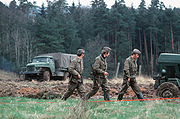
- Field Service Uniform (Felddienstuniform) - The summer field uniform for both officers and enlisted consisted of a jacket and trousers in a dark-brown (later a forest green) raindrop camouflage pattern on a stone-gray background; a field cap, service cap, or steel helmet; high black boots; and a leather belt with vertical web shoulder suspenders. In winter, a quilted stone gray padded suit without a camouflage pattern was worn over the service uniform. Later winter uniforms were also of the same camouflage pattern as the summer variant. The winter uniform also included a fur pile capPile capA pile cap is a thick concrete mat that rests on concrete or timber piles that have been driven into soft or unstable ground to provide a suitable stable foundation. It usually forms part of the foundation of a building, typically a multi-storey building, structure or support base for heavy...
or a steel helmet, boots, knitted gray gloves, belt, and suspenders.
- Service Uniform (Dienstuniform) - The summer service uniform for officers was a bloused jacket worn without a shirt, trousers, and a visored service cap. The winter service uniform featured a jacket with four large buttoned-down patch pockets, a black waist belt, the service cap, breeches, shirt, tie, and pants belt; high boots were reserved for officers and NCOs. A long, heavy, belted greatcoat was also part of the winter uniform.
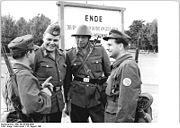
- Semi-Dress/Walking-Out Uniform (Ausgangsuniform) - With a few details, the semi-dress uniform was the same for all ranks and was worn for walking-out purposes (i.e. off-duty and off-post). It consisted of a single-breasted tunic without belt, a silver-gray shirt with dark-gray tie, the service cap, long trousers, and black low-quarter shoes. Officers also wore the tunic with a white shirt. During periods of warm weather, there was the option of omitting the tunic, and furthermore omitting the tie. For a time, a double-breasted jacket was optional for officers and warrant officers.
- Parade Uniform (Paradeuniform) - The parade uniform for officers was the semi-dress/walking-out tunic with all authorized orders, awards and decorations attached, breechesBreechesBreeches are an item of clothing covering the body from the waist down, with separate coverings for each leg, usually stopping just below the knee, though in some cases reaching to the ankles...
and riding boots, steel helmet, white shirt, dark-gray necktie, and a ceremonial dagger worn on the left side and fastened to a silver-gray parade belt. Officers in guards of honor carried sabers. In winter, a greatcoat, scarf, and gloves were worn.
- Work Uniform (Arbeitsuniform) - Seasonal considerations and weather governed the kind of work uniforms worn. Generally, reconditioned articles of service uniforms (field, semi-dress, and padded winter uniforms) were dyed black and issued for all types of fatigue and maintenance details. Coveralls are also used by the lower ranks, especially armor and air force personnel. Officers in technical branches supervising fatigue details wore a laboratory-style smock.
- Other Uniforms — High-ranking officers occasionally wore white uniforms (or white jackets), and staff officers were issued distinctive staff service uniforms. Women wore uniforms consisting of jackets, skirts or slacks, blouses, caps, boots or pumps, and other appropriate items according to season and occasion. Personnel such as paratroopers, motorcyclists, and tank troops wore additional items with their uniforms identifying them as such.
Waffenfarben
NVA uniforms initially wore the waffenfarbeWaffenfarbe
Waffenfarbe is a means the German military uses to distinguish between different corps or troop functions in its armed services...
n as worn by the Wehrmacht, but later reverted to white except for generals who wore red.
The uniform of the Border Troops is distinguished from that of the NVA ground force and Air Force/Air Defense Force by a green armband with large silver letters identifying the wearer's affiliation.
Felix Dzerzhinsky Guards Regiment uniforms were nearly identical to those of the those of (NVA) and were distinguished primarily by the dark red MfS service color of its insignia and by an honorary cuffband on the left sleeve bearing the regiment's name. Other Stasi
Stasi
The Ministry for State Security The Ministry for State Security The Ministry for State Security (German: Ministerium für Staatssicherheit (MfS), commonly known as the Stasi (abbreviation , literally State Security), was the official state security service of East Germany. The MfS was headquartered...
officers wore a similar uniform, but without the cuffband.
Rank Insignia
East German armed forces personnel display rank insignia on shoulder boards or shoulder loops on service, semidress, and parade uniforms, and subdued sleeve insignia midway between the shoulder and elbow on the left sleeve of the field uniform, coveralls, or other special uniforms. General officer rank is denoted by five-pointed silver stars mounted on a gold and silver braided shoulder cord set on a bright red base. All other officers and NCOs wear a four-pointed star. Like many of the other Warsaw Pact countries, NVA rank insignia followed the Soviet pattern in the arrangement of stars.The Volksmarine followed similar insignia for the naval officers and NCOs' except that these were blue colored.
Insignia of the NVA Ground Forces and Air Force
| General Officers of the NVA Ground Forces/Air Force | ||||
|---|---|---|---|---|
| Marschall der DDR (Marshal of the DDR) | Armeegeneral Armeegeneral Armeegeneral was a senior military rank of East Germany, used until 1990. It was the equivalent of a Four-Star-General in Western nations and ranked below the Marschall der DDR , although no one was ever promoted to the latter rank.East German officers who achieved the rank of Armeegeneral were:*... (General of the Army General of the Army General of the Army is a military rank used in some countries to denote a senior military leader, usually a General in command of a nation's Army. It may also be the title given to a General who commands an Army in the field.... ) |
Generaloberst (Colonel General Colonel General Colonel General is a senior rank of General. North Korea and Russia are two countries which have used the rank extensively throughout their histories... ) |
Generalleutnant (Lieutenant General Lieutenant General Lieutenant General is a military rank used in many countries. The rank traces its origins to the Middle Ages where the title of Lieutenant General was held by the second in command on the battlefield, who was normally subordinate to a Captain General.... ) |
Generalmajor (Major General Major General Major general or major-general is a military rank used in many countries. It is derived from the older rank of sergeant major general. A major general is a high-ranking officer, normally subordinate to the rank of lieutenant general and senior to the ranks of brigadier and brigadier general... ) |
 |
 |
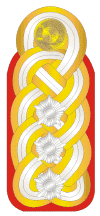 |
 |
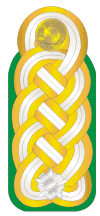 |
| Field and Company Grade Officers of the NVA Ground Forces/Air Force | ||||||
|---|---|---|---|---|---|---|
| Oberst Oberst Oberst is a military rank in several German-speaking and Scandinavian countries, equivalent to Colonel. It is currently used by both the ground and air forces of Austria, Germany, Switzerland, Denmark and Norway. The Swedish rank överste is a direct translation, as are the Finnish rank eversti... (Colonel) |
Oberstleutnant Oberstleutnant Oberstleutnant is a German Army and Air Force rank equal to Lieutenant Colonel, above Major, and below Oberst.There are two paygrade associated to the rank of Oberstleutnant... (Lieutenant Colonel) |
Major Major Major is a rank of commissioned officer, with corresponding ranks existing in almost every military in the world.When used unhyphenated, in conjunction with no other indicator of rank, the term refers to the rank just senior to that of an Army captain and just below the rank of lieutenant colonel. ... |
Hauptmann Hauptmann Hauptmann is a German word usually translated as captain when it is used as an officer's rank in the German, Austrian and Swiss armies. While "haupt" in contemporary German means "main", it also has the dated meaning of "head", i.e... (Captain Captain (OF-2) The army rank of captain is a commissioned officer rank historically corresponding to command of a company of soldiers. The rank is also used by some air forces and marine forces. Today a captain is typically either the commander or second-in-command of a company or artillery battery... ) |
Oberleutnant Oberleutnant Oberleutnant is a junior officer rank in the militaries of Germany, Switzerland and Austria. In the German Army, it dates from the early 19th century. Translated as "Senior Lieutenant", the rank is typically bestowed upon commissioned officers after five to six years of active duty... (First Lieutenant First Lieutenant First lieutenant is a military rank and, in some forces, an appointment.The rank of lieutenant has different meanings in different military formations , but the majority of cases it is common for it to be sub-divided into a senior and junior rank... /Senior Lieutenant Senior lieutenant Senior lieutenant is a military grade between a lieutenant and a captain. Sometimes senior lieutenant is called a first lieutenant.... ) |
Leutnant (Lieutenant Lieutenant A lieutenant is a junior commissioned officer in many nations' armed forces. Typically, the rank of lieutenant in naval usage, while still a junior officer rank, is senior to the army rank... ) |
Unterleutnant (Sub-Lieutenant Sub-Lieutenant Sub-lieutenant is a military rank. It is normally a junior officer rank.In many navies, a sub-lieutenant is a naval commissioned or subordinate officer, ranking below a lieutenant. In the Royal Navy the rank of sub-lieutenant is equivalent to the rank of lieutenant in the British Army and of... /Second Lieutenant Second Lieutenant Second lieutenant is a junior commissioned officer military rank in many armed forces.- United Kingdom and Commonwealth :The rank second lieutenant was introduced throughout the British Army in 1871 to replace the rank of ensign , although it had long been used in the Royal Artillery, Royal... ) |
 |
 |
 |
 |
 |
 |
 |
| Officer Candidates/Warrant Officers of the NVA Ground Forces/Air Force | |||
|---|---|---|---|
| Stabsoberfähnrich (Chief Staff Ensign) | Stabsfähnrich (Staff Ensign) | Oberfähnrich (Senior Ensign) | Fähnrich Fähnrich Fähnrich is a German and Austrian military rank in armed forces which translates as "Ensign" in English. The rank also exists in a few other European military organizations, often with historical ties to the German system. Examples are Sweden, Norway and Finland . The French Army has a similar... (Ensign) |
 |
 |
 |
 |
| Non Commissioned Officers of the NVA Ground Forces/Air Force | ||||
|---|---|---|---|---|
| Stabsfeldwebel (Sergeant Major/Staff Senior Sergeant) | Oberfeldwebel (Senior Sergeant) | Feldwebel Feldwebel Feldwebel is a German military rank which has existed since at least the 18th century with usage as a title dating to the Middle Ages. The word Feldwebel is usually translated as sergeant being rated OR-6 in the NATO rank comparison scale, equivalent to the British Army Sergeant and the US Army... (Sergeant 1st Class/Sergeant) |
Unterfeldwebel (Sergeant/Junior Sergeant) | Unteroffizier Unteroffizier Unteroffizier is both a specific military rank as well as a collective term for non-commissioned officers of the German military that has existed since the 19th century. The rank existed as a title as early as the 17th century with the first widespread usage occurring in the Bavarian Army of the... (Corporal/Under Officer) |
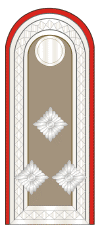 |
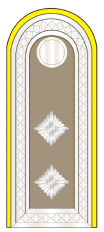 |
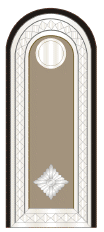 |
 |
 |
| Enlisted Ranks of the NVA Ground Forces/Air Force | ||
|---|---|---|
| Stabsgefreiter (Lance Corporal) | Gefreiter Gefreiter Gefreiter is the German, Swiss and Austrian equivalent for the military rank Private . Gefreiter was the lowest rank to which an ordinary soldier could be promoted. As a military rank it has existed since at least the 16th century... (Private 1st Class) |
Soldat (Private) |
 |
 |
 |
Ranks of the People's Navy
Enlisted rates
- Matrose - Seaman RecruitSeaman RecruitSeaman recruit is the lowest enlisted rank in the U.S. Navy and U.S. Coast Guard, just below seaman apprentice; this rank was formerly known as seaman third class...
- Obermatrose - Seaman Apprentice
- Stabsmatrose- Seaman
- Maat auf Zeit- Petty Officer 3rd Class
- Obermaat aut Zeit- Petty Officer 2nd Class
- Maat - Petty Officer 1st ClassPetty Officer 1st ClassPetty officer, 1st class, PO1, is a Naval non-commissioned member rank of the Canadian Forces. It is senior to the rank of petty officer 2nd-class and its equivalents, and junior to chief petty officer 2nd-class and its equivalents. Its Army and Air Force equivalent is warrant officer .The French...
- Obermaat - Chief Petty Officer
- Meister - Senior Petty Officer
- Obermeiser - Master Chief Petty Officer
- Stabsobermeiser - Staff Master Chief Petty Officer
Officer candidates/Warrant officers
- FähnrichFähnrichFähnrich is a German and Austrian military rank in armed forces which translates as "Ensign" in English. The rank also exists in a few other European military organizations, often with historical ties to the German system. Examples are Sweden, Norway and Finland . The French Army has a similar...
- MidshipmanMidshipmanA midshipman is an officer cadet, or a commissioned officer of the lowest rank, in the Royal Navy, United States Navy, and many Commonwealth navies. Commonwealth countries which use the rank include Australia, New Zealand, South Africa, India, Pakistan, Singapore, Sri Lanka and Kenya... - Oberfahnrich - Senior Midshipman
- Stabsfahnrich - Staff Midshipman
- Stabsoberfahrich - Senior Staff Midshipman
Officers
- Unterleutnant zur See - Sea Under Lieutenant/Ensign
- Leutnant zur See - Sea LieutenantLieutenantA lieutenant is a junior commissioned officer in many nations' armed forces. Typically, the rank of lieutenant in naval usage, while still a junior officer rank, is senior to the army rank...
/Lieutenant Junior Grade - Oberleutnant zur See - Sea Senior Lieutenant
- Kapitanleutnant - Captain LieutenantCaptain LieutenantCaptain lieutenant or captain-lieutenant is a military rank, used in a number of different navies worldwide.It is generally equivalent to the Commonwealth or US rank of lieutenant, and has the NATO rank code of OF-2, though this can vary....
- Korvettekapitan - Lieutenant CommanderLieutenant CommanderLieutenant Commander is a commissioned officer rank in many navies. The rank is superior to a lieutenant and subordinate to a commander...
/Corvette CaptainCorvette CaptainCorvette captain is a rank in many navies which theoretically corresponds to command of a corvette . The equivalent rank in the United Kingdom, Commonwealth and USA is lieutenant commander... - Fregattenkapitan - CommanderCommanderCommander is a naval rank which is also sometimes used as a military title depending on the individual customs of a given military service. Commander is also used as a rank or title in some organizations outside of the armed forces, particularly in police and law enforcement.-Commander as a naval...
/Frigate Captain - Kapitan zur See - CaptainCaptain (naval)Captain is the name most often given in English-speaking navies to the rank corresponding to command of the largest ships. The NATO rank code is OF-5, equivalent to an army full colonel....
/Ship-Of-The-Line Captain - Konteradmiral - Counter AdmiralCounter AdmiralCounter admiral is a rank found in many navies of the world, but no longer used in English-speaking countries, where the equivalent rank is rear admiral...
/Rear AdmiralRear AdmiralRear admiral is a naval commissioned officer rank above that of a commodore and captain, and below that of a vice admiral. It is generally regarded as the lowest of the "admiral" ranks, which are also sometimes referred to as "flag officers" or "flag ranks"... - Vizeadmiral - Vice AdmiralVice AdmiralVice admiral is a senior naval rank of a three-star flag officer, which is equivalent to lieutenant general in the other uniformed services. A vice admiral is typically senior to a rear admiral and junior to an admiral...
- AdmiralAdmiralAdmiral is the rank, or part of the name of the ranks, of the highest naval officers. It is usually considered a full admiral and above vice admiral and below admiral of the fleet . It is usually abbreviated to "Adm" or "ADM"...
- Flottenadmiral - Admiral of the FleetAdmiral of the FleetAn admiral of the fleet is a military naval officer of the highest rank. In many nations the rank is reserved for wartime or ceremonial appointments...
Awards and Decorations
The DDR had some seventy decorations for persons or groups it wished to recognize, and it bestowed them liberally. Some, such as battle decorations, were specifically set aside for armed forces personnel, many awarded to soldiers and civilians alike, and others, although ordinarily civilian awards, can on occasion be earned by those on military duty. The latter group included decorations for achievement in the arts, literature, production, and work methods. They were awarded to service personnel or specific units that participated in civil production projectsCivic action program
A civic action program also known as civic action project is a type of operation designed to assist an area by using the capabilities and resources of a military force or civilian organization to conduct long-term programs or short-term projects...
or assisted during harvesting.
The Order of Karl Marx
Order of Karl Marx
The Order of Karl Marx was the most important order in the German Democratic Republic . Award of the order also included a prize of 20,000 East German marks....
, Order of Merit
Order of Merit
The Order of Merit is a British dynastic order recognising distinguished service in the armed forces, science, art, literature, or for the promotion of culture...
, Star of People's Friendship, Banner of Labor
Banner of Labor
The Banner of Labor was an order issued in the German Democratic Republic .It was given for "outstanding achievements of many years which stabilized and strengthened the country, and in particular for high results of working in the national economy"....
, Order of Scharnhorst, Order of Merit for the Fatherland
Order of Merit for the Fatherland
The Order of Merit for the Fatherland was instituted on 2 March 1994 by Presidential Decree. The statutes describe it as a decoration for merit, not an order of knights....
, and the National Prize
National Prize of East Germany
The National Prize of the German Democratic Republic was an award of the German Democratic Republic given out in three different classes for scientific, artistic, and other meritorious achievement...
were among the more important awards. Some, including the Order of Merit and the Star of People's Friendship, were awarded in three classes. A few were accompanied by substantial monetary premiums. The NVA did not permit military personnel to wear Wehrmacht
Wehrmacht
The Wehrmacht – from , to defend and , the might/power) were the unified armed forces of Nazi Germany from 1935 to 1945. It consisted of the Heer , the Kriegsmarine and the Luftwaffe .-Origin and use of the term:...
awards and decorations.
Periodicals
The two main periodicals of the NVA were the weekly newspaper Volksarmee and the monthly soldier's magazine ArmeerundschauArmeerundschau
From 1956 to 1990, Armeerundschau or “AR” was a monthly soldier’s magazine for members of the East German National People’s Army...
.
Relics
The former Nazi holiday complex at ProraProra
Prora is a beach resort on the island of Rügen, Germany, known especially for its colossal Nazi-planned touristic structures. The massive building complex was built between 1936 and 1939 as a Kraft durch Freude project. The eight buildings are identical, and while they were planned as a holiday...
, on the island of Rügen
Rügen
Rügen is Germany's largest island. Located in the Baltic Sea, it is part of the Vorpommern-Rügen district of Mecklenburg-Vorpommern.- Geography :Rügen is located off the north-eastern coast of Germany in the Baltic Sea...
, contains a number of museum displays. One of these is devoted to the NVA, which had used part of the complex as a barracks.
See also
- Conscientious objection in East GermanyConscientious objection in East Germany-Introduction of conscription:In April 1962 the GDR government introduced military conscription. The period of compulsory service was at least 18 months, and adult males between 18 and 26 were eligible...
- Combat Groups of the Working ClassCombat Groups of the Working ClassThe Combat Groups of the Working Class was a paramilitary organization in East Germany, founded in 1953 and abolished in 1990. It numbered about 400,000 volunteers for much of its existence.-History:...
- Felix Dzerzhinsky Guards Regiment
- Medal of Merit of the National People's ArmyMedal of Merit of the National People's ArmyThe Medal of Merit of the National People's Army was a medal issued in the German Democratic Republic .Established on June 1, 1956 in three levels, Gold, Silver and Bronze...
- Military history of Germany
Further reading
- Bickford Andrew. Fallen Elites: The Military Other in Post-Unification Germany (Stanford University Press; 2011); 288 pages; An ethnographic study of former East German officers.
- Dale Roy Herspring, Requiem for an army: the demise of the East German military, Rowman & Littlefield Publishers, 1998, ISBN 084768718X, 9780847687183, 249 pages
- Jörg SchönbohmJörg SchönbohmJörg Schönbohm is a German politician and a retired Lieutenant General. He was the first commander of the Bundeswehr Eastern Command in 1990, which supervised the absorption of the East German National People's Army into the Federal German armed forces...
, Two armies and one fatherland: the end of the Nationale Volksarmee, Berghahn Books, 1996, ISBN 1571810692, 9781571810694 - Zilian, Jr., Frederick. 'From Confrontation to Cooperation: The Takeover of the National People's (East German) Army by the Bundeswehr,' Praeger, Westport, Conn., 1999, ISBN 0-275-96546-5. Reviewed by Dale R. Herspring in The Journal of Military History, July 2000, p. 912-914
External links
- NVA Forum (in German)
- Nationale Volksarmee & the GDR Forum
- AHF - Nationale Volksarmee (NVA)
- kamouflage.net > Europe > Germany, Democratic Republic of
- RFE/RL East German Subject Files: Armed Forces Open Society Archives, Budapest

